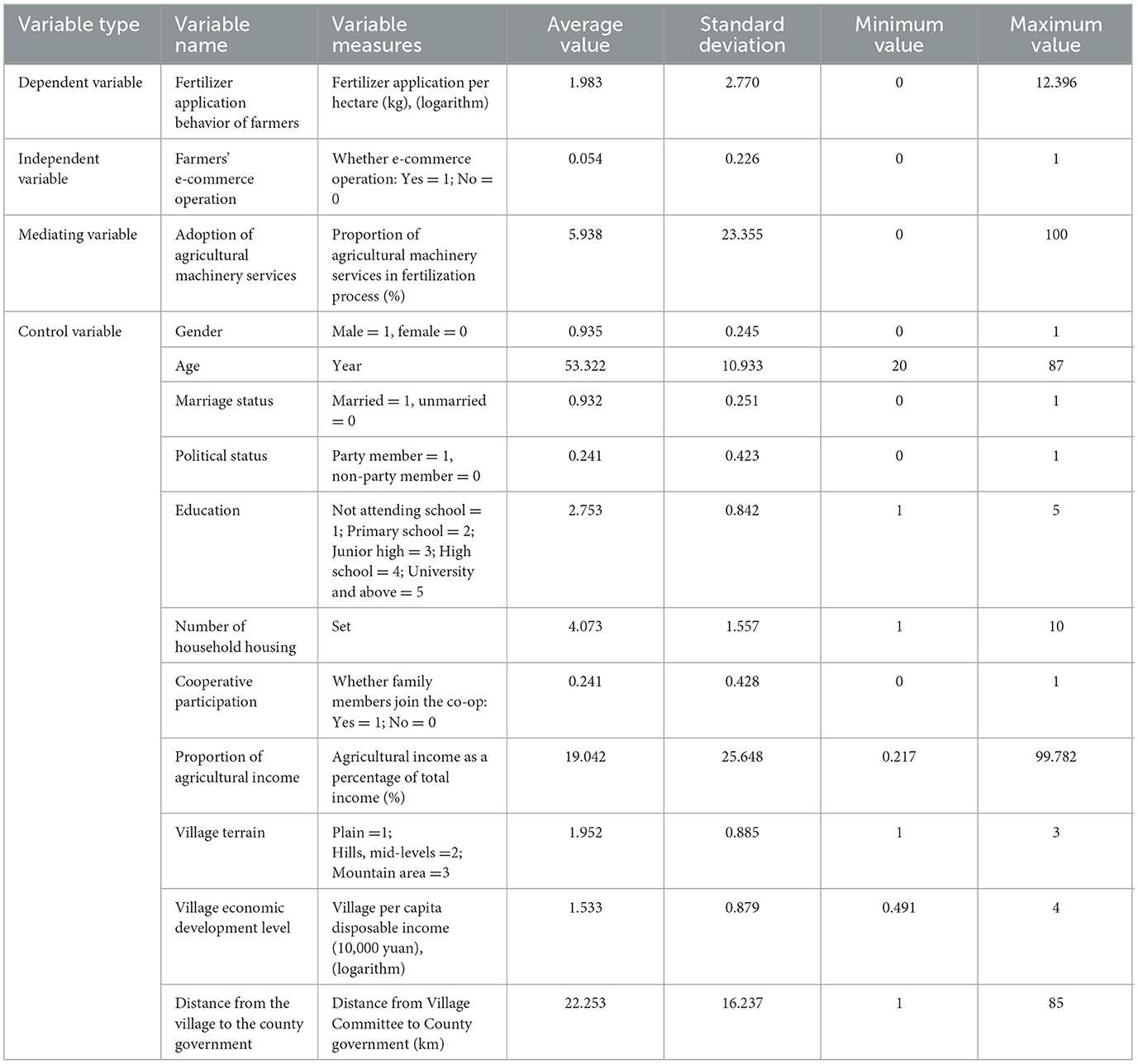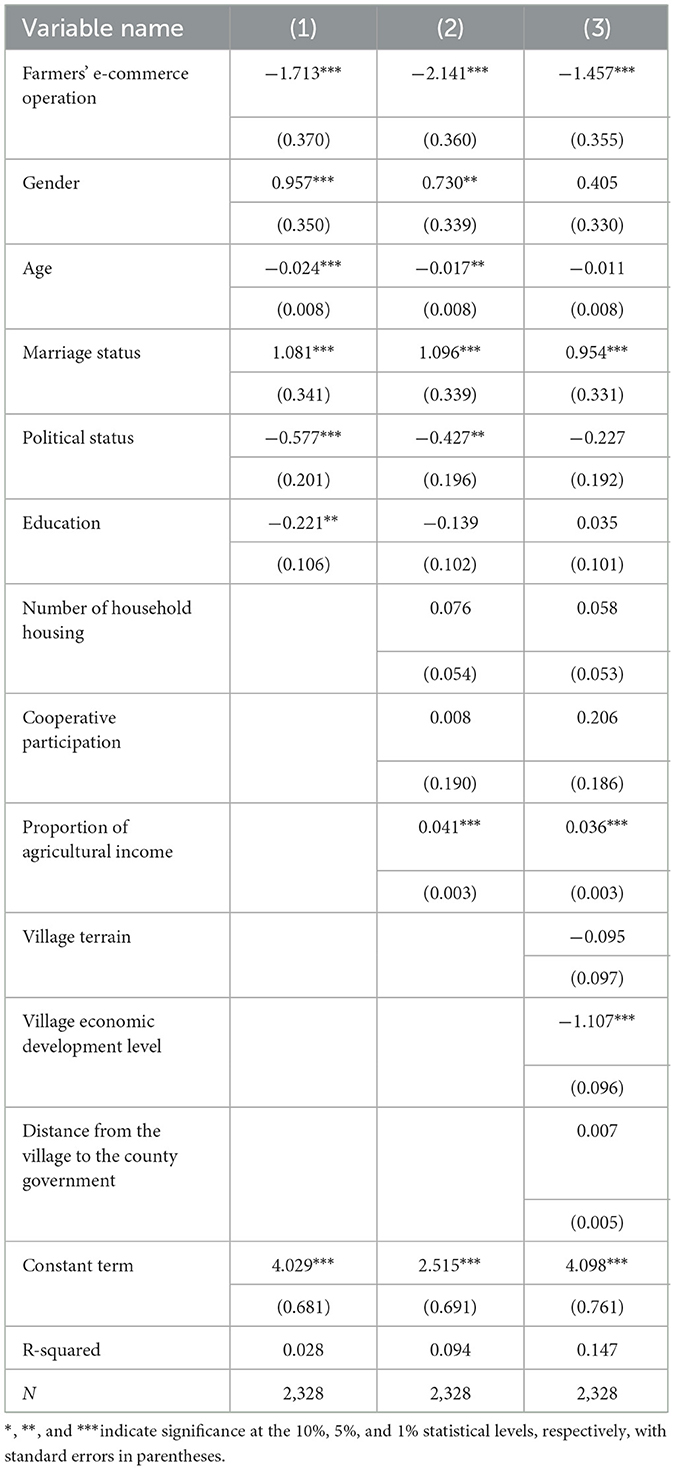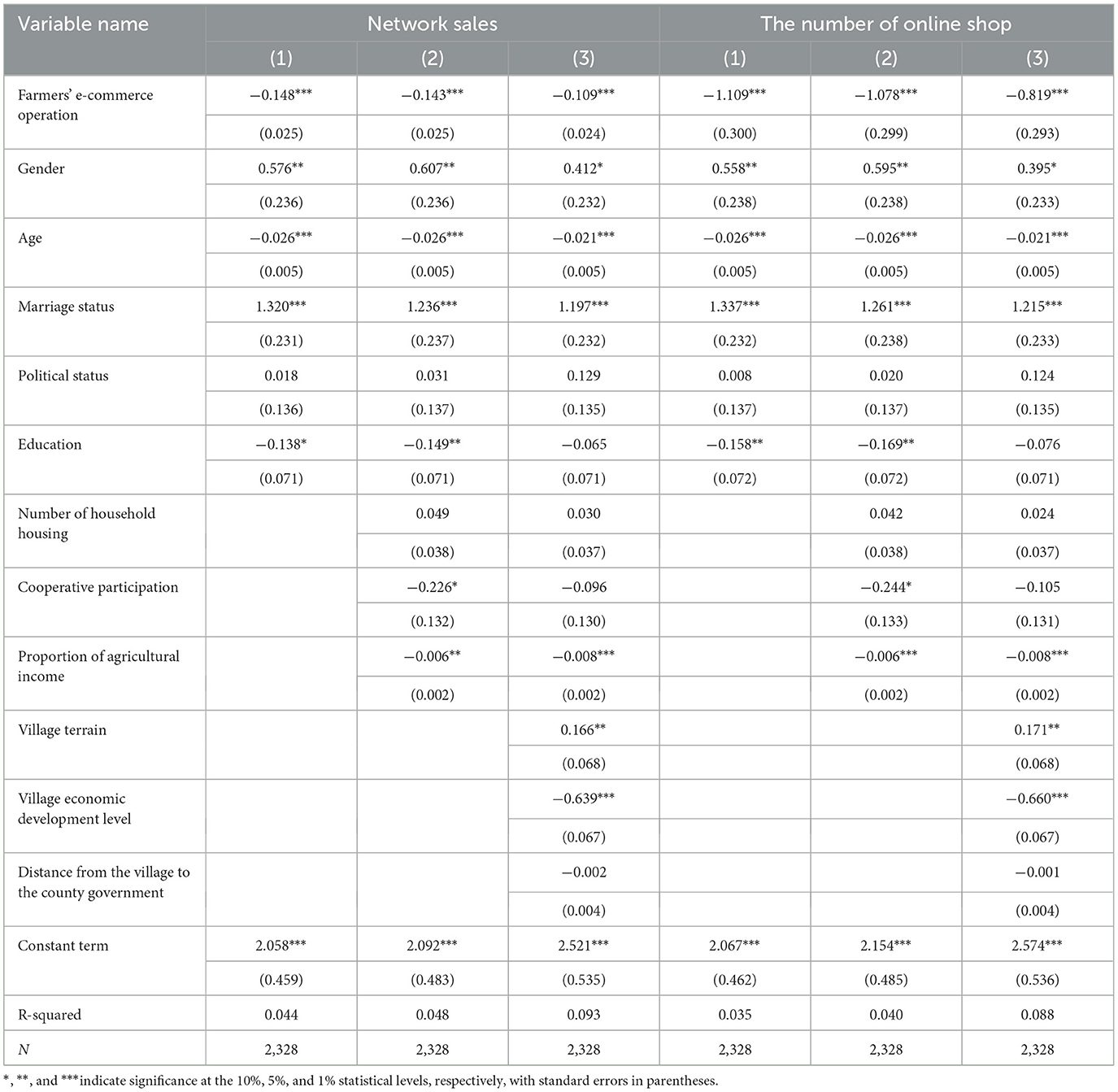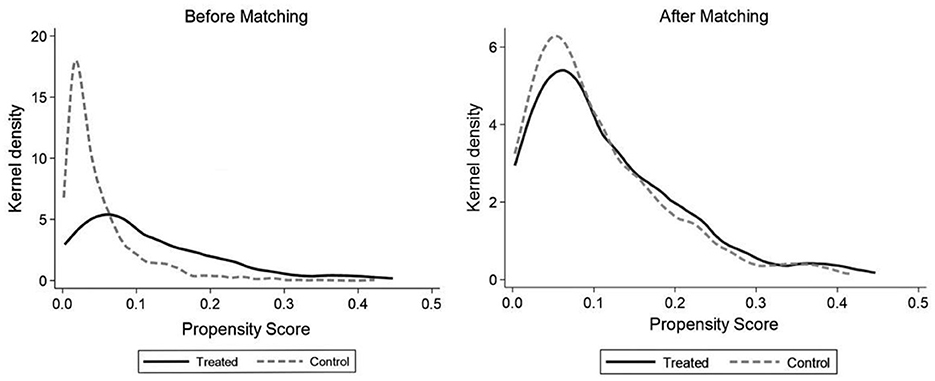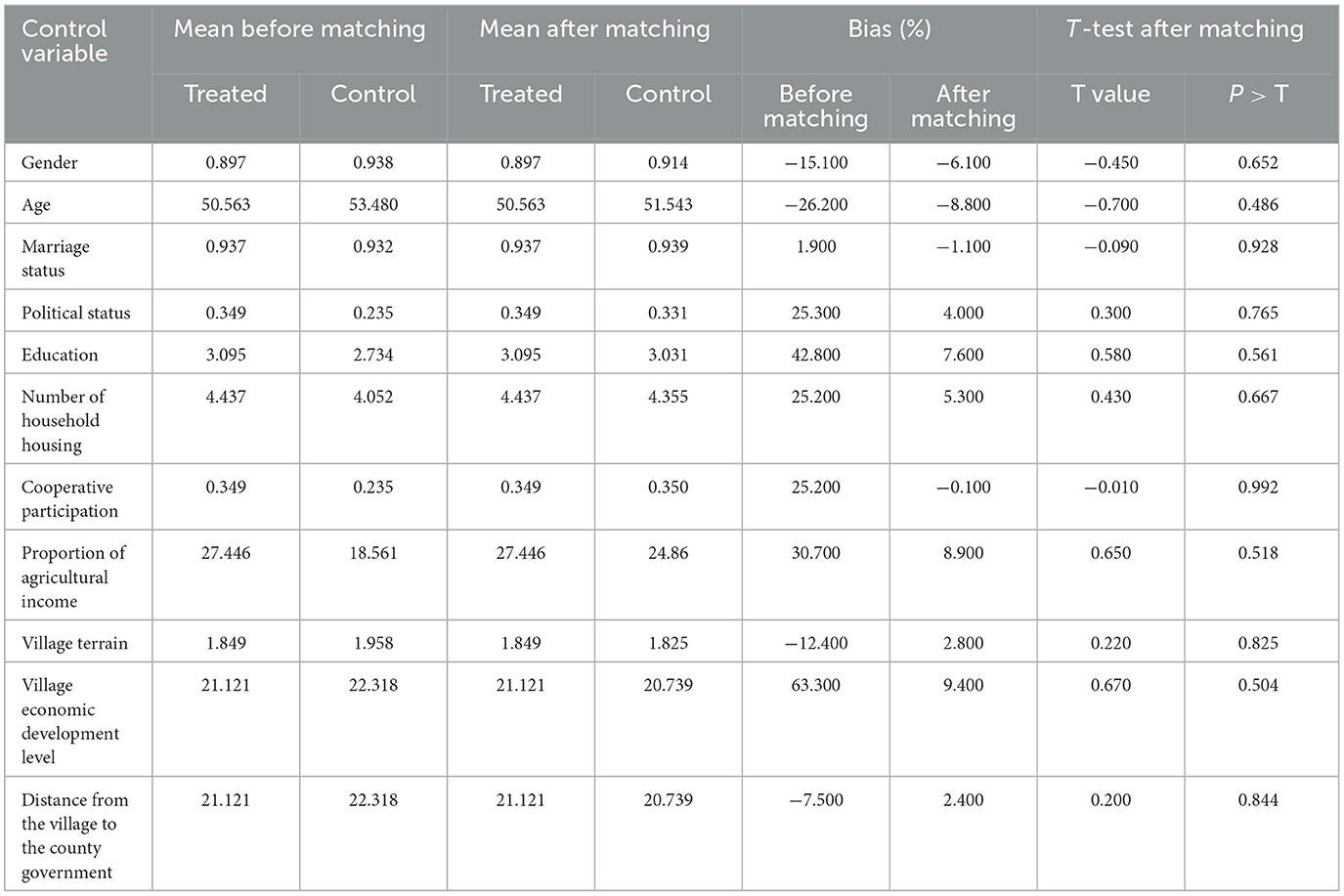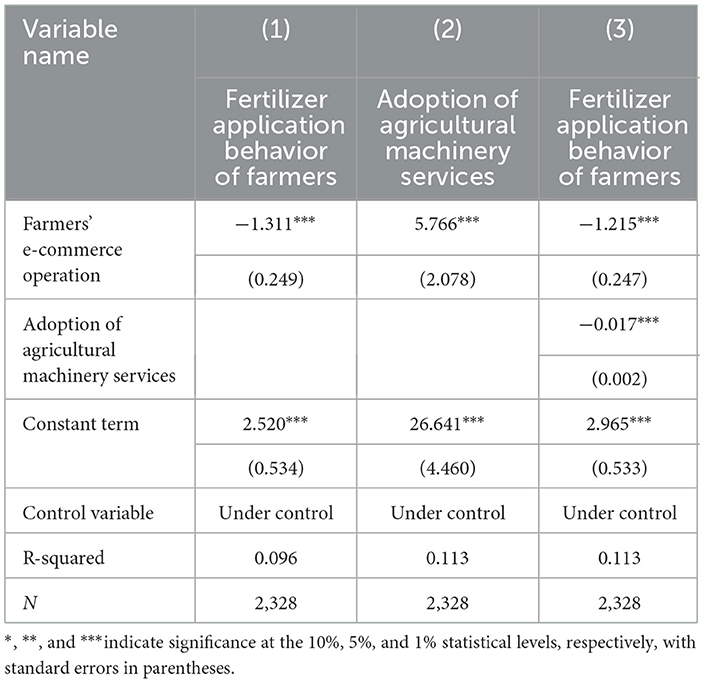- 1School of Economics and Management, Jiangxi Agricultural University, Nanchang, China
- 2School of Social and Public Administration, Lingnan Normal University, Zhanjiang, China
- 3Business School, The University of Hong Kong, Hong Kong, China
- 4School of Economics, Management and Law, Jiangxi Science and Technology Normal University, Nanchang, China
Introduction: How e-commerce businesses improve farmers' fertilizer application (FFA) and reduced fertilizer application is of great practical significance.
Methods: Using the data from the China Rural Revitalization Survey (CRRS) in 2020, the OLS and mediating effect models were exploited to explore the impact and mechanism of e-commerce operation (EO) on FFA by examining this heterogeneous effect. We further explored the differences in fertilizer reduction effects of different EO's scales and modes.
Results and discussion: The results show that e-commerce operation significantly negatively impacts farmers ' chemical fertilizer (CF), reducing CF's amount. The results of the mediating effect test show that agricultural machinery service plays an intermediary role in the influence of EO on FFA. The heterogeneity analysis shows that e-commerce operation has a heterogeneous impact on FFA regarding gender, agricultural functional zoning, and regional distribution. E-commerce operations can encourage women, major grain-producing areas, and farmers in the central and western regions to reduce fertilizer. Further discussion indicates that scale e-commerce and social e-commerce also perform the fertilizer reduction effect. Therefore, policy makers are suggested to encourage the transformation of rural industries into e-commerce to stimulate the production sector to reduce fertilizer use. These measures help developing countries balance economic growth and environmental protection, and promote sustainable ecological development.
Introduction
The realization of green transformation and sustainable development in agriculture necessitates the optimization of fertilizer usage to enhance agricultural sustainability. The green transformation of agricultural production refers to the promotion of environmentally friendly and sustainable practices within the sector. The primary objective is to minimize reliance on chemical inputs, such as fertilizers and pesticides, while enhancing ecological resource protection and improving resource utilization efficiency through technological innovation. In contrast to traditional production systems that heavily depend on high levels of fertilizers and pesticides to maintain output, this approach signifies a fundamental shift in agricultural production—from a “high input, high output” model to one that prioritizes environmental sustainability. On one hand, fertilizers can significantly improve yield and quality; they are indispensable inputs for agricultural production and play a crucial role in addressing global food security challenges. China stands as the world's largest producer and consumer of fertilizers (Pourhosseini et al., 2024). On the other hand, the overuse and improper application of fertilizers have become increasingly prevalent, leading to adverse consequences such as resource wastage, environmental contamination, and soil acidification. This issue is particularly pronounced against the backdrop of advancements in agricultural technology coupled with population growth in rural areas (Zhang et al., 2020). Evidence from the Asian Development Bank indicates that excessive dependence on chemical fertilizers has been widespread among many developing countries for an extended period, highlighting the challenging task ahead in reducing fertilizer usage.
China, one of the most populous countries in the world, achieved a fertilizer output of 5,446 tons in 2021, positioning itself among the global leaders in both total fertilizer production and consumption (Ji et al., 2023). However, China has not effectively improved the technology in using fertilizers and faced unreasonable and unscientific aspects in the application (Liu and Diamond, 2005; Ju et al., 2009; Zhu and Chen, 2002; Cheng et al., 2011). The agricultural system in China has historically depended on a high-input production model to ensure high and stable grain yields (Hu et al., 2019). The excessive application of chemical inputs such as chemical fertilizers in the process of the agricultural output will lead to agricultural severe non-point source pollution, resulting in increased environmental and ecological loads of agricultural resources (Huang and Rozelle, 1996; Wang et al., 2022), the decline in the quality of agricultural products and a series of adverse feedback loop problems (Liu et al., 2015; Zhao et al., 2019). In 2015, the Ministry of Agriculture and Rural Affairs of China developed the “Zero Growth Action Plan for Fertilizer Use by 2020” and initiated actions aimed at achieving zero growth in fertilizer usage. By the end of 2020, China's chemical fertilizer reduction and efficiency increase have successfully achieved the expected goals. However, reducing chemical fertilizer application in agricultural production is still arduous. As shown in Figure 1, China's fertilizer application per hectare has long been higher than the world average, and the level of developed countries and the gap was on the rise. The total amount of chemical fertilizer application in China has remained high all year round, far exceeding the level of developed countries. Consequently, while sustaining economic growth, addressing how to continuously reduce chemical fertilizer usage has emerged as a critical concern not only for China but also for many developing countries worldwide.
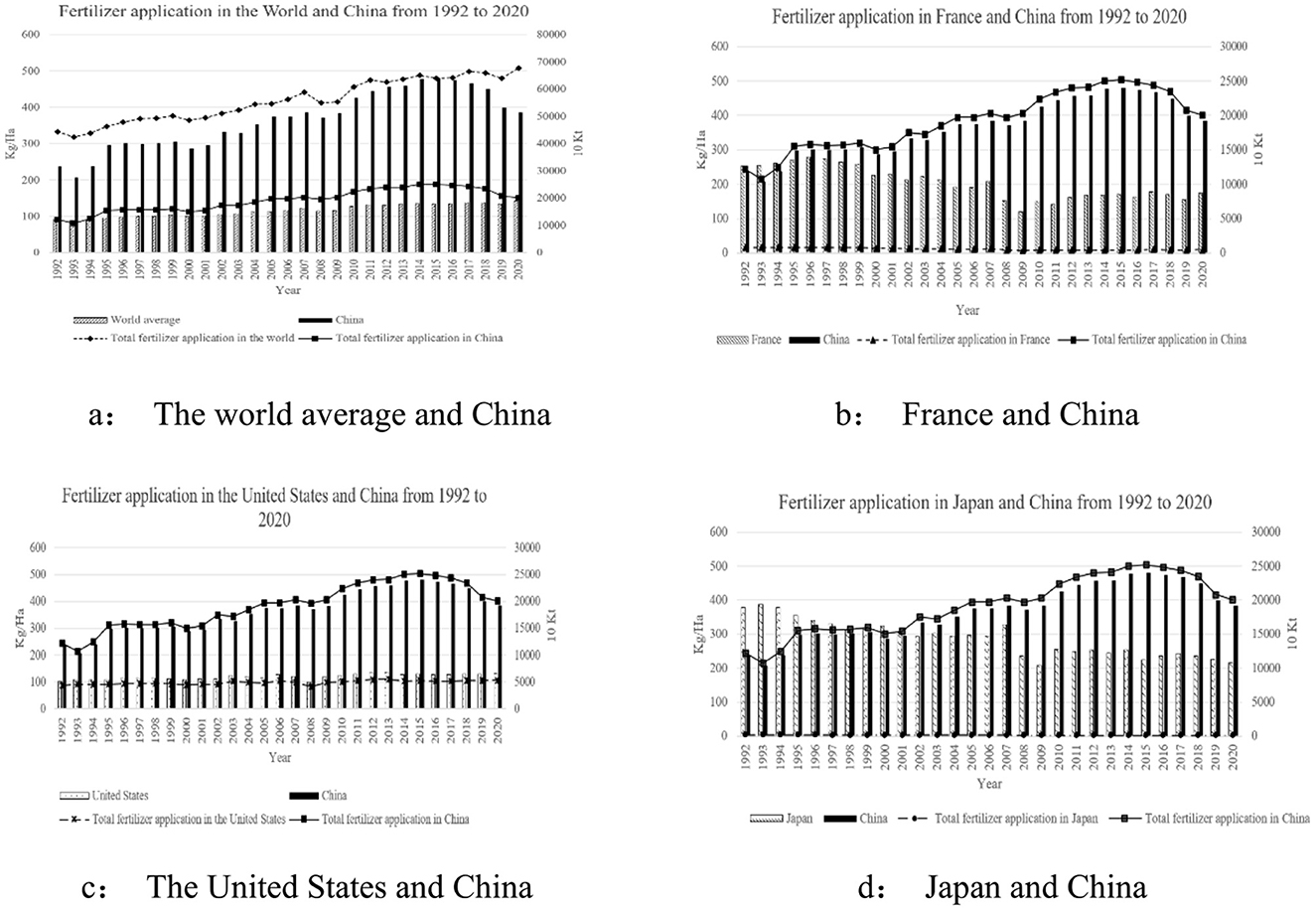
Figure 1. Fertilizer application in the world and China from 1992 to 2020. (a) The world average and China. (b) France and China. (c) The United States and China. (d) Japan and China. Data source: World Bank database.
In-depth discussions regarding the factors influencing farmers' fertilizer application (FFA) behavior have been conducted across three primary aspects. First, the individual endowments of farmers play a crucial role. As the central agents in chemical fertilizer reduction, farmers' willingness to reduce usage and their potential technical needs hold significant behavioral implications. Characteristics such as age, education level, ecological awareness, and risk attitudes substantially influence the effectiveness of fertilizer reduction (Zheng et al., 2022; Tian et al., 2022; Ren, 2023). Additionally, factors such as planting willingness and intergenerational differences notably affect the quantity of chemical fertilizers applied by farmers in the present period (Zeng et al., 2019), while farming experience passed down through generations also impacts their fertilizer application practices. The second aspect pertains to agricultural business models. Ecological management approaches exemplified by 'rice-shrimp co-culture' demonstrate a significant capacity for reducing fertilizer use and can effectively lower the amount of chemical fertilizers that farmers apply (Liu et al., 2022). Agricultural socialized services can effectively reduce the amount of chemical fertilizer farmers apply (Chen and Liu, 2023). By facilitating mechanized fertilization alongside the expansion of farmland management scales and increasing farmers' incomes, these services promote a reduction in chemical fertilizer usage and inhibit its intensity through various means (Yang and Li, 2022; Wu et al., 2018; Huan et al., 2022). Furthermore, policy interventions have encouraged farmers to decrease their reliance on chemical fertilizers.
On the one hand, by giving farmers subsidies, sharing farmers' fertilization costs, and improving farmers' income expectations, farmers' willingness to reduce chemical fertilizer can be effectively enhanced (Guo et al., 2021; Yang et al., 2022). On the other hand, the fertilizer utilization rate was improved by direct intervention in farmers ' fertilizer application behavior (Stuart et al., 2014; Lv et al., 2023). Regarding agricultural product sales, the government encourages a transition toward green production through market mechanisms by increasing consumer subsidies for green consumption prices (Tian et al., 2022). This approach aims to motivate farmers to enhance their production methods and decrease their reliance on chemical fertilizers at the production level (He et al., 2023).
E-commerce has shown a vigorous development trend in rural areas of China. Data released by the National Bureau of Statistics of China shows that in 2023, the national online retail sales reached 2.237 trillion US dollars, up 11.0% from the previous year. Among them, the online retail sales in rural areas reached 361 billion US dollars, nearly 13 times that of 2014; the online retail sales of agricultural products across the country reached 85.11 billion US dollars, up 12.5% year-on-year. Developing countries like Egypt, India, and Vietnam have also announced rural e-commerce expansion plans (Couture et al., 2021). Rural e-commerce is increasingly being recognized as a new growth point for the rural economy in developing nations (Li, 2017; Qiu et al., 2024). The vigorous development of agricultural e-commerce in China has had a significant impact on the country's traditional agricultural development model that relies excessively on the use of agricultural fertilizers and pesticides (Lin et al., 2016; Liu et al., 2021). Here, agricultural e-commerce is defined as a business model based on the Internet and the Internet of Things for trading agricultural materials and products, enabling farmers to effectively break through geographical restrictions and participate in national and global economic development (Aker and Ksoll, 2016; Liu et al., 2021). Other studies have shown that the development of e-commerce has a significant reduction effect on agricultural non-point source pollution (Wang et al., 2022), and the use of the Internet has a significant direct impact on farmers' reduction of pesticides (Zhao et al., 2021). Under the context of agricultural green transformation, the excessive application of fertilizers has intensified environmental pollution and soil degradation. However, e-commerce, through technological empowerment—such as precise agricultural information dissemination and market connectivity for organic products—has the potential to reshape farmers' production decisions and encourage a reduction in fertilizer usage. Investigating the relationship between these two factors not only offers a novel approach to addressing the issue of agricultural non-point source pollution but also provides empirical evidence for policy design aimed at leveraging the digital economy to promote sustainable development. This endeavor holds both ecological significance and practical necessity. Farmers' fertilizer reduction behavior is an endogenous response to changes in key economic variables, which are inevitably influenced by the development of agricultural e-commerce. Agricultural e-commerce serves as a powerful mechanism for marketization. While it impacts farmers' sales methods and economic income, it also has the potential to extend the production chain upward and transmit effects to the production end, thereby influencing the safety of agricultural product production. To elucidate its effects, we aim to address the following questions: (1) Can e-commerce operations incentivize farmers to reduce their fertilizer application? (2) If so, what is the underlying impact mechanism? (3) Is there heterogeneity in how e-commerce operations affect farmers' fertilizer application behaviors?
This paper investigates the impact and mechanisms of e-commerce operations (EO) on farmers' fertilizer application (FFA), utilizing data from the China Rural Revitalization Survey conducted in 2020. Additionally, it further analyzes this heterogeneous impact. The objective of our research is to provide both theoretical and empirical insights for China and, by extension, for many developing countries, thereby facilitating the green transformation of agricultural production (GTAP) methods. Compared with existing studies, the marginal contribution of this paper may lie in the following aspects. First, it focuses on the environmental effects of e-commerce operations, explores the behavioral logic of farmers' reduction in chemical fertilizer use from the perspective of e-commerce operations, constructs a theoretical framework of “e-commerce operations—agricultural machinery services—reduction in chemical fertilizer use”, and uses national micro-survey data to measure the effect and mechanism of e-commerce operations on farmers' chemical fertilizer application behavior, thus enriching the relevant research on the influencing factors of farmers' chemical fertilizer application behavior. Second, it considers the differences in farmers' endowments and regional endowments, and examines the heterogeneous impact of e-commerce operations on farmers' chemical fertilizer application behavior. To further verify this analysis, this paper uses the geographical detector factor to verify the sampled provinces, ensuring that the treatment effect of e-commerce services does not have spatial correlation and ensuring the robustness of the treatment effect. Finally, it further discusses the differences in the impact of different e-commerce operation scales and e-commerce operation models on farmers' chemical fertilizer application behavior, providing targeted suggestions for the green transformation of agriculture and the protection of rural ecological environment.
The remainder of this article is structured as follows. The second section presents the theoretical analysis and research hypotheses. The third section discusses the data sources, variable selection, and model construction. Following that is an examination of the empirical results. Finally, the fifth section concludes with research findings and policy implications.
Theoretical analysis
As a quintessential representative of the digital economy model, e-commerce has significantly contributed to the green transformation of agricultural production methods. It not only enhances market transparency but also reduces transaction costs. Through information disclosure and feedback mechanisms, e-commerce encourages farmers to adopt environmentally friendly production technologies. Furthermore, the implementation of agricultural machinery services has further improved fertilizer use efficiency and facilitated a reduction in chemical fertilizers. However, due to factors such as individual farmer endowments and regional conditions, the impacts of e-commerce operations may exhibit heterogeneity.
The impact of e-commerce operation on farmers ' fertilizer application
The Global Trade in Agricultural Products (GTAP) program encounters significant challenges due to the absence of both positive incentive mechanisms and negative punitive measures. Specifically, agricultural products often lack adequate quality ratings and green certifications, which hinders their ability to gain a competitive advantage in the marketplace. Concurrently, the insufficient implementation of punishment mechanisms for non-green production practices ultimately diminishes farmers' motivation to transition toward sustainable production methods (Herzfeld and Jongeneel, 2012). The shift from traditional production models to greener alternatives frequently entails higher production costs; however, the limited premium potential associated with fragmented green agricultural products makes it challenging for farmers to realize increased profits. This situation further reduces the impetus for GTAP engagement (Yin et al., 2022). As a novel catalyst for transforming agricultural development models, e-commerce has played a pivotal role in significantly reducing chemical fertilizer usage (Li et al., 2021). It encourages farmers to adopt organic and compound fertilizers while minimizing reliance on chemical inputs. This shift effectively mitigates agricultural non-point source pollution and generates substantial environmental benefits (Zhang et al., 2022; Shen et al., 2022).
Firstly, e-commerce enhances market transparency, raises the price expectations of green products, and boosts farmers' willingness to engage in green production, thereby encouraging them to reduce the use of chemical fertilizers. In traditional agricultural business models, due to information asymmetry and an unfair competitive environment, producers are prone to engage in inferior-quality speculative behavior, and the “price mechanism” that reflects product quality is at risk of failure (Ji et al., 2023). The development of e-commerce expands the market scope, intensifies competition in the agricultural product market, improves the problem of information asymmetry (Zhang et al., 2022), and enhances the efficiency of the agricultural product sales market (Guo et al., 2022; Yang et al., 2024; Yi et al., 2023), providing the possibility of “higher price for better quality” for green agricultural products and ultimately promoting a reduction in the use of chemical fertilizers (He et al., 2023). Secondly, e-commerce can expand the sales range, lower transaction costs, and increase sales revenue, enabling farmers to have more funds for green production investment and thus reduce the use of chemical fertilizers. On one hand, the e-commerce business model can break through geographical limitations, expand the sales range of agricultural products, and alleviate the problem of no increase in income despite a bumper harvest caused by product homogeneity (Leong et al., 2016). On the other hand, the e-commerce business model enhances farmers' bargaining power over their products, reduces intermediate links and dependence on middlemen, lowers transaction costs in the sales process, increases income, and strengthens farmers' willingness to invest in production (Goetzke et al., 2014). The scale and quality of social networks also affect the e-commerce sales of agricultural products, and the scale and quality of social networks are influenced by the “word-of-mouth effect”. Good product word-of-mouth is the key to the long-term operation of farmers' e-commerce, which makes farmers choose to adopt green production technologies and reduce the use of chemical fertilizers in pursuit of positive product evaluations (Lin and Wang, 2018). At the same time, the information disclosure and feedback mechanisms embedded in e-commerce platforms enable consumers to clearly and intuitively obtain relevant information about product quality and the relationships between producers and consumers, as well as among consumers (Kolotylo-Kulkarni et al., 2021). Unobstructed information exchange and two-way feedback allow consumers to better understand the production process, thereby forming value recognition and purchase stickiness, and supervising the quality and safety of agricultural products, which prompts farmers to pay more attention to green production and increases their willingness to reduce the use of chemical fertilizers (Yan and Liu, 2022). Hence, the research hypothesis 1 is proposed.
H1: EO has a significant negative impact on FFA and can reduce this amount.
The mechanism of e-commerce operation
Rural e-commerce can break through the limitations of time and space, reconstruct the cooperation channels between production and marketing, and generate a cluster effect, enabling scattered small-scale farmers to engage in industrial cooperation, expand the scale of land operation, increase the demand for mechanized production operations, and encourage farmers to adopt agricultural machinery services. At the same time, the adoption of e-commerce can increase income, enhance farmers' investment willingness and capacity, and encourage farmers to increase agricultural investment in agricultural machinery, organic fertilizers, etc. (Yan and Liu, 2022). The development of the rural e-commerce industry further promotes the improvement of regional infrastructure and the optimal allocation of resource elements, facilitates the transformation of agricultural production toward the GTAP model of mechanization and standardization, promotes the wide application of agricultural machinery services in agricultural production, and forces local agricultural production to transform toward intensification, refinement, and intelligence (Lin et al., 2022). Compared with manual fertilization, farmers' adoption of agricultural machinery services for fertilization (Wang et al., 2018, 2022) can effectively increase fertilizer utilization rates and reduce the use of chemical fertilizers. Mechanized fertilization is more fixed in terms of quantity in both time and space dimensions, usually showing higher standardization (Ji et al., 2023), which can prevent over-fertilization. At the same time, the use of automated, intelligent, and precise agricultural machinery services for fertilization can effectively improve the traceability of fertilizer use and enhance the credibility of “green” products, thereby encouraging farmers to reduce fertilizer input (Yuan et al., 2021). Additionally, in response to the government's green production requirements and under the constraints of reputation capital and market competition, agricultural machinery service providers tend to offer higher-quality fertilizers and green agricultural materials such as organic fertilizers (Li et al., 2014; Fang et al., 2021), thereby encouraging farmers to increase the use of organic fertilizers and reduce the application of chemical fertilizers. Hence, the following hypothesis 2 is proposed.
H2: E-commerce reduces FFA by promoting farmers ' adoption of agricultural machinery services.
The heterogeneous impact of e-commerce operation
Given the differences in individual endowments of farmers and regional conditions, the impact of e-commerce operations on family farm agriculture may be heterogeneous. First, due to the influence of industrialization and urbanization, coupled with gender imbalance in the labor market, to maximize the total household income, the phenomenon of family labor, especially male labor, going out to work has significantly increased. In contrast, female labor has more options to stay in rural areas and take on the responsibility of caring for the family and engaging in agricultural production (Kaspar, 2005; Fang, 2023). The opportunities for farmers to receive green production training have also increased, and they are more inclined to reduce the use of chemical fertilizers (Yuan et al., 2022). Second, the impact of e-commerce operations on family farm agriculture is influenced by agricultural functional zoning. Compared with non-grain production areas, grain production areas have better quality of cultivated land and agricultural infrastructure, and higher requirements for the quality of agricultural products, which provides a favorable external environment for the reduction of chemical fertilizers in e-commerce operations. At the same time, the concentration of contiguous cultivated land resources in grain production areas is conducive to mechanization and precise fertilization, improving the efficiency of fertilizer application, making fertilization more efficient and precise, and thereby promoting the reduction of chemical fertilizers (Ji et al., 2023). Finally, the impact of e-commerce operations on the reduction of chemical fertilizers is influenced by regional distribution. Central and western provinces are located inland, with agriculture dominated by crop cultivation, more abundant cultivated land resources, and more diverse and strict support policies for cultivated land quality protection. Objectively, this increases the possibility for farmers to reduce the use of chemical fertilizers. As the e-commerce market gradually penetrates rural areas, farmers in central and western regions have a clearer understanding of green production. They are more inclined to reduce the use of chemical fertilizers to obtain higher product premiums and expand market sales. Hence, this paper proposes Hypothesis 3:
H3: The impact of EO on FFA is heterogeneous in gender, agricultural functional zoning, and regional distribution.
Materials and methods
Data sources
China's fertilizer reduction action plan was initiated in 2015 and implemented over a five-year period, concluding in 2020. Prior to this initiative, Chinese farmers frequently over applied pesticides and fertilizers on their fields, resulting in significant soil pollution. A survey conducted by the Chinese Academy of Agricultural Sciences in 2015 across 20 intensive vegetable-growing areas in five northern provinces revealed that the average nitrogen fertilizer application rate exceeded the internationally recognized upper limit of 225 kilograms per hectare in most regions of China. At that time, an investigation by the Henan Provincial Department of Agriculture indicated that only one-third of more than three million tons of fertilizers were effectively absorbed by crops. Among over 800 surveyed locations, it was found that ~50% exhibited groundwater nitrate levels surpassing acceptable standards due to excessive nitrogen fertilizer usage. In 2015, central and southeastern regions of China (excluding Jiangxi and Shanxi) emerged as potential high-risk areas for elevated nitrate concentrations in groundwater attributable to excessive nitrogen fertilizer application. Consequently, in 2017, the Ministry of Agriculture and Rural Affairs of China issued an action plan aimed at substituting chemical fertilizers with organic alternatives specifically within fruit, vegetable, and tea cultivation sectors.
To capture the micro-characteristics of family farms in farmland cultivation, relevant data can be sourced from the “China Rural Revitalization Survey,” organized by the Institute of Rural Development at the Chinese Academy of Social Sciences. This survey was initiated in August and September 2020 and officially released in October 2022. The rationale for selecting this survey data lies in its focus on core aspects of rural development, including rural population dynamics, labor force participation, industrial structure, and consumption patterns among rural residents. Furthermore, the research team conducts follow-up surveys biennially, thereby ensuring high levels of data accuracy and relevance to this study. During the sampling process for data collection, 10 sample provinces were randomly selected from various regions—eastern, central, western, and northeastern—including Guangdong, Zhejiang, Shandong, Anhui, Henan, Heilongjiang, Guizhou, Sichuan, Shaanxi, and Ningxia. This selection considered factors such as economic development levels, regional locations, and agricultural conditions. Subsequently, all counties within each province were ranked according to per capita GDP; fifty sample counties were then chosen using an equal-interval sampling method while also taking into account the spatial distribution of these counties. Next, the towns and villages within the sampled counties were ranked based on their economic development levels. From this ranking,156 sample towns and 300 sample villages were randomly selected. Finally,3,833 farmer samples were randomly drawn based on lists provided by village committees. In accordance with the requirements of this study, after eliminating missing values and outliers related to key variables, a total of 2,328 valid samples were ultimately retained for analysis.
This paper analyzes the situation of Taobao villages and fertilizer application in the sample provinces, and the results are shown in Figure 2. Meanwhile, this paper conducts the identification of geographical detection factors (Cao et al., 2013). The results indicate that the coefficients for e-commerce operations and agricultural machinery service adoption are 0.778 and 0.610, respectively, with both significance levels exceeding 0.1. This implies that the influence effects of e-commerce operations and agricultural machinery service adoption do not exhibit spatial correlation. Furthermore, through interaction detection analysis, the interaction coefficient between e-commerce operations and agricultural machinery service adoption is 0.853, but its spatial correlation coefficient is also >0.1, which is not statistically significant. This demonstrates that the interplay between e-commerce operations and agricultural machinery service adoption does not exhibit spatial correlation and is not spatially varied by the number of Taobao Villages.
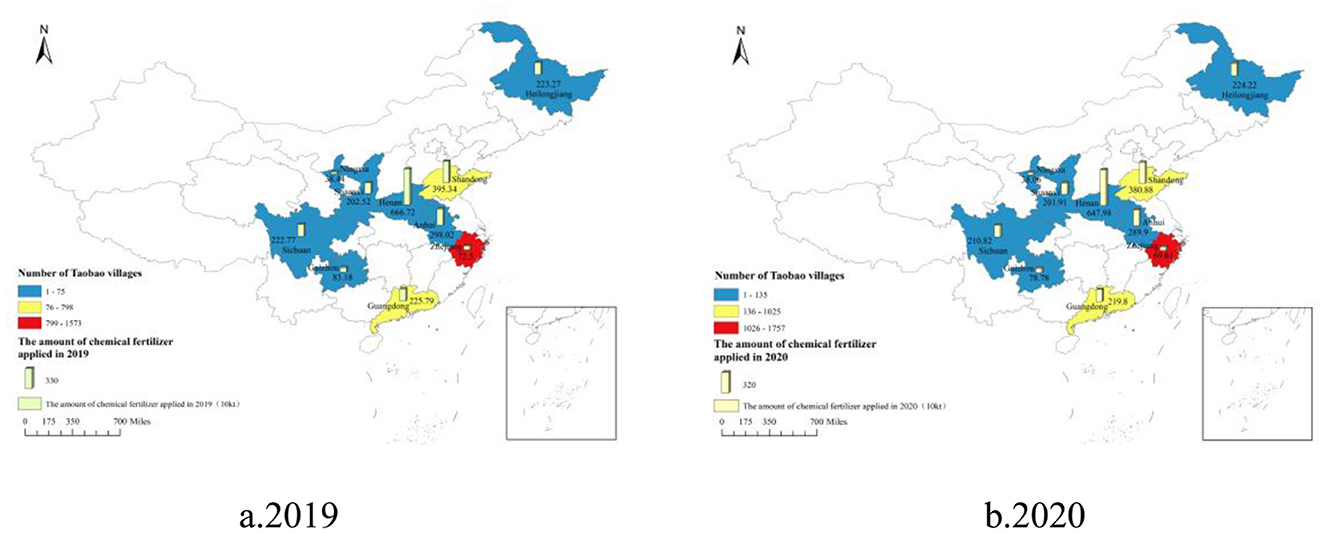
Figure 2. Distribution of the number of Taobao Villages and fertilizer application in selected provinces, 2019–2020. (a) 2019. (b) 2020.
Variables
Dependent variables
Following Ji et al. (2023), the dependent variable of this paper is the behavior of FFA measured by the amount of fertilizer applied per hectare. To weaken the potential heteroscedasticity problem of the model, this paper logarithmicizes the amount of fertilizer used per hectare (Wooldridge, 2015).
Core independent variable
The core independent variable of this paper is e-commerce operation. With the rapid development of information technology and the widespread popularity of the Internet in rural areas, rural e-commerce has received more and more attention. This paper selects “whether your home is operating and has products through online transactions” in the farmer's questionnaire to measure EO and regards the participation of farmers in online transactions with a value of 1; otherwise, 0.
Mediating variables
The intermediary variable of this paper is the adoption of agricultural machinery services. By encouraging farmers to adopt agricultural machinery services, e-commerce operations improve the accuracy and standardization of fertilizer application, thereby reducing fertilizer application. This paper takes the proportion of agricultural machinery service in fertilization to measure agricultural machinery service adoption.
Control variables
Referring to the research of Huang et al. (2015), Wang et al. (2018) and Wu et al. (2018), this paper selects control variables from the three dimensions of individual characteristics, family characteristics, and regional characteristics of farmers. Among them, individual characteristics include gender, age, marital status, political outlook, and education level; family characteristics include family population size, cooperative participation, and proportion of agricultural income; regional characteristics include village topography, village economic development level, and the distance between the village and the county government. The specific variable description and descriptive statistical characteristics are shown in Table 1.
This paper compared the amount of chemical fertilizer applied by farmers operating e-commerce and those not operating e-commerce. Figure 3 is the density distribution map and cumulative distribution map of farmers' CF amounts. The “density y” refers to the kernel density plot of the amount of chemical fertilizer applied by farmers. It can be seen from the graph that the amount of fertilizer applied by farmers who operate e-commerce was less than that of farmers who do not operate e-commerce. It can be preliminary judged that e-commerce operation plays a vital role in promoting farmers' fertilizer reduction. The following empirically analyzed the impact of e-commerce operations on farmers' fertilizer applications.
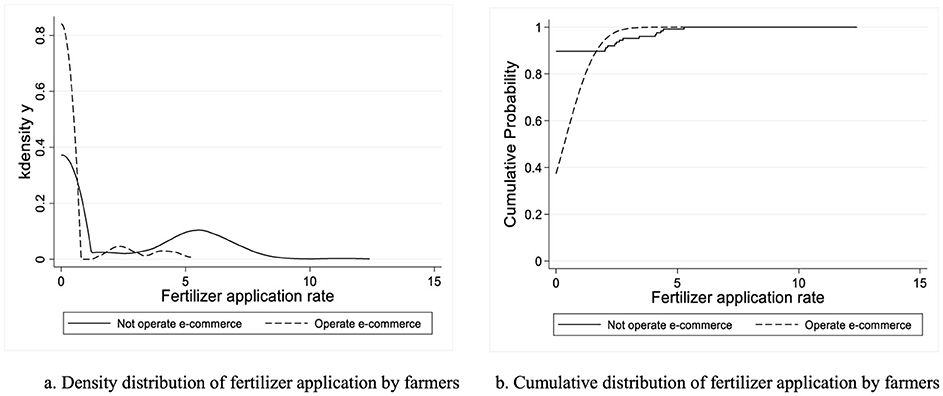
Figure 3. Density distribution and cumulative distribution of chemical fertilizer amount applied by farmers. (a) Density distribution of fertilizer application by farmers. (b) Cumulative distribution of fertilizer application by farmers.
Model construction
OLS model
Since the dependent variables are continuous variables, the OLS Model was used to analyze the influence of e-commerce operations on farmers' chemical fertilizer application behavior. The specific model was set as follows:
WhereCh_Fer represents the dependent variable,Ecom represents the core independent variable, Xrepresents the control variable, and ε is the random disturbance term.
The mediating effect model
Drawing on Baron and Kenny's (1986) research, this paper used the stepwise regression method to examine the intermediary role of agricultural machinery services. The first step was to test the impact of e-commerce operation on the application behavior of farmers, and the second step was to test the effect of e-commerce operation on the adoption of agricultural machinery services. Next, the impact of e-commerce operation and agricultural machinery service adoption on the application behavior of farmers was tested. The mediation effect model was set as follows:
Among them, Yi represents the amount of fertilizer applied by the I farmer per hectare and takes logarithmic form; Ecomi represents the i farmer e-commerce operation; Mi represents the intermediary variable, namely the adoption of agricultural machinery services;Xi represents other control variables, including individual characteristics, family characteristics and regional characteristics; α1 is the total effect of e-commerce operation on farmers' fertilizer application behavior, β1 is the influence of e-commerce operation on intermediary variables, ϕ1is the direct effect of e-commerce operation on farmers' fertilizer application behavior, and ϕ2 is the direct effect of the intermediary variable on farmers' fertilizer application behavior; εi is the random disturbance term.
Results
Base line regression
The regression results of the influence of e-commerce operation on the chemical fertilizer application behavior of farmers are shown in Table 2. Columns (1), (2), and (3), respectively, show the regression results of individual characteristics, family characteristics, and regional characteristics. The regression results show that EO has a significant negative impact on CF. That is, e-commerce operation significantly reduces the amount of CF they apply. Hypothesis 1 was verified, confirming the pro-environmental effect of e-commerce operations.
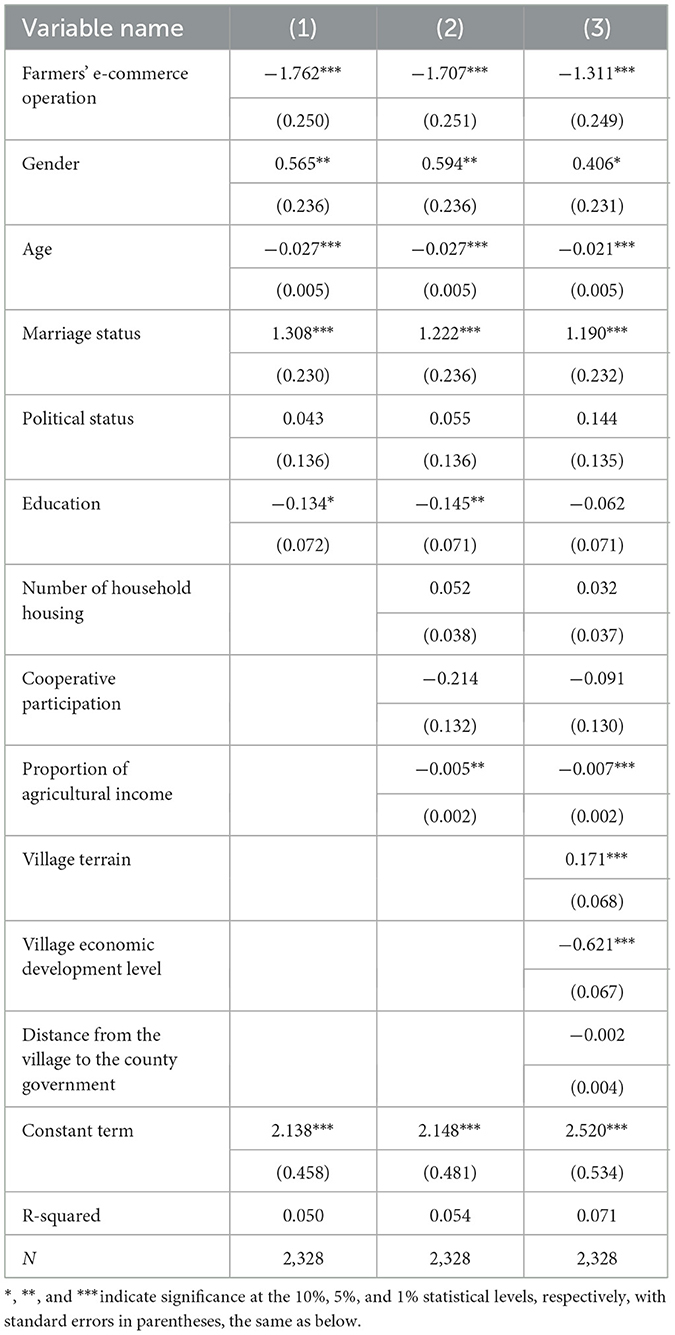
Table 2. Benchmark regression results of e-commerce operations on farmers' fertilizer application behaviors.
Among the control variables, age, the proportion of agricultural income, and the level of village economic development had a significant adverse effect on the fertilizer application behavior of farmers, which could reduce the FFA. Gender, marital status, and village topography significantly positively affected FFA. Under the influence of urbanization and industrialization, most of the young labor force goes out to work. It engages in non-agricultural work, while the rural labor force in agricultural production is older and more likely to adopt new technologies to reduce fertilizer. For farmers with a high proportion of agricultural income, their income sources mainly depend on agricultural production activities. They pay more attention to the economic benefits of green production and are more inclined to reduce fertilizer application. For villages with high economic development levels, their farmland infrastructure is more perfect, and farmers are more likely to use machinery in fertilization, which is conducive to reducing the amount of fertilizer application. Affected by urbanization and industrialization, male household heads are more likely to work outside the farm and are more inclined to increase the amount of fertilizer application to reduce the time input cost of agricultural production. Marriage has a restrictive effect on farmers' production behavior. Compared with unmarried farmers, married farmers shoulder more family responsibilities, are more conservative in production decision-making, and are more inclined to increase agricultural income by increasing fertilizer application. Compared with villages in plain areas, those in mountainous regions have a higher degree of land fragmentation, making it more difficult to use mechanical operations to reduce the application of chemical fertilizers.
Robustness test
The replacement of dependent variables
To better investigate the impact of e-commerce operations on farmers' fertilizer application behavior, referring to the study of Chen and Liu (2023), this paper takes the amount of fertilizer expenditure per hectare (the total amount of fertilizer expenditure divided by the total sown area of main grain crops) as the measurement index of the dependent variable. It conducts a robustness test, with the results shown in Table 3. The results show that the regression results after replacing the dependent variables are consistent with the baseline results. EO has a significant negative impact on FFA, which can reduce the amount of FFA, as it is robust with the above estimation.
The replacement of the core independent variable
To replace the dependent variables, this paper further verifies the robustness of the previous regression results by replacing the core independent variables. In this paper, online sales and the number of online stores are taken as the measurement indicators of e-commerce operation, and regression is conducted again. The results are shown in Table 4. The results show that EO significantly negatively impacts the FFA and can reduce the amount of FFA, indicating that the baseline regression results are robust.
Endogeneity test
Self-selection bias
Farmers' EO is a kind of “self-selection” behavior, which is affected by variables such as household owner and family characteristics rather than random, which may cause the problem of sample self-selection and the resulting endogenous bias, leading to the deviation of the estimation results of OLS Model. To solve the problem of endogeneity caused by self-selection bias, this paper uses the Propensity Score Matching (PSM) Method to investigate the effects of e-commerce operations on the fertilizer application behavior of farmers. As shown in Table 5, after considering the endogenous problem of self-selection bias, EO still significantly negatively affects FFA, reducing this amount.
The PSM Model specification can satisfy both the overlap hypothesis and the equilibrium property (Caliendo and Kopeinig, 2008). For the overlap hypothesis, it is necessary to test the common support domain. Figure 4 shows the distribution of propensity scores for testing the common support domain. Compared with before the matching, the matching e-commerce business samples and non-e-commerce business samples almost overlap in the propensity score, and there is a large standard support interval, indicating that the matching effectiveness is supported, PSM effectively reduces the difference in the distribution of independent variables between the treatment group and the control group and eliminates the estimation bias caused by sample self-selection.
To investigate whether the propensity score matching estimation results can balance the data well, the balance test results are shown in Table 6. The results show that the standardized deviation rate of control variables is reduced after matching, and the standard deviation rate is < 10%. The T-test results of the control variables do not reject the null hypothesis that there is no systematic difference between the experimental group and the control group and effectively balance the differences in the distribution of covariables between the experimental group and the control group. Therefore, the results of propensity score matching pass the balance test.
Reverse causality
Endogenous problems may be caused by mutual causation between EO and FFA. On the one hand, e-commerce reduces fertilizer application by encouraging farmers to adopt agricultural machinery services. On the other hand, after reducing the amount of fertilizer applied, the quality of agricultural products has improved, the economic value in the market is higher, and farmers are more inclined to expand the sales range through the e-commerce platform. To solve the endogenous problem caused by mutual causality, this paper draws on the existing research (Zhang et al., 2023), takes the average proportion of EO of other farmers in the village except this farmer as the instrumental variable, and uses 2SLS (Two Stage Least Square) method to re-estimate. Due to the “peer effect,” the e-commerce operation of other farmers in the village will affect the EO but will not directly affect FFA, which meets the correlation and exogeneity requirements of instrumental variables and is reasonable.
The endogenous test results of the impact of EO on FFA are shown in Table 7. Wald test value is statistically significant at a 1% level, indicating that the null hypothesis of exogenous variables is rejected. That is, there is an endogeneity problem. The first-stage regression results show that the EO ratio of other farmers in the village has a significant positive impact on this farmer, and the F-value of the joint significance test is >10, indicating no problem with weak instrumental variables. At the same time, the results of the second stage regression all show that EO still has a significant negative impact on FFA after considering the endogeneity problem, which further verifies the reliability of the research results in this paper and the coefficient is higher than the regression coefficient of OLS model, which also means that if the endogeneity problem of reverse causation is not considered, It is possible to underestimate the positive effect of EO on the reduction of FFA.
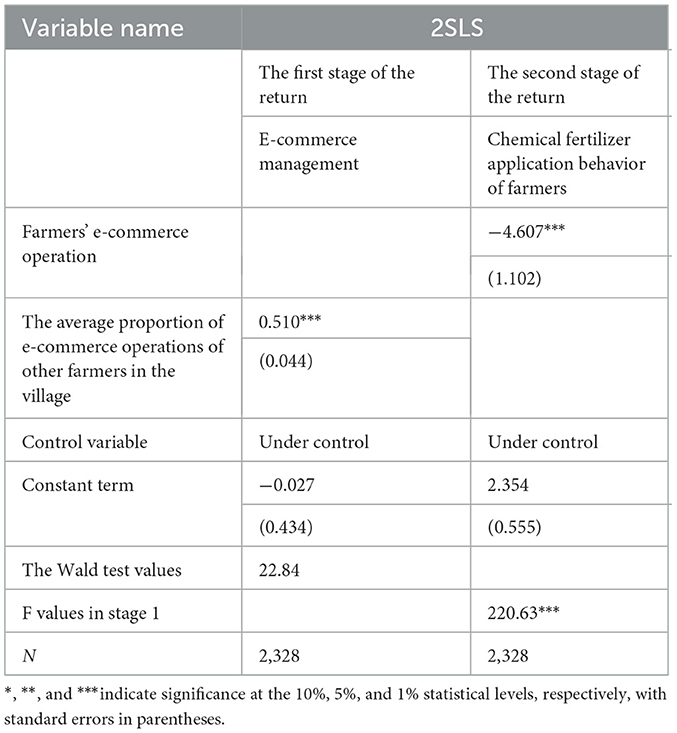
Table 7. 2SLS estimation results of the impact of e-commerce operations on farmers' fertilizer application behavior.
Mediation effect analysis
The mediation effect method is used to verify the above mechanism, and the results are shown in Table 8. E-commerce reduces fertilizer application by promoting farmers' adoption of agricultural machinery services, and hypothesis 2 was verified. According to the regression results, agricultural machinery services partially mediate the relationship between EO and FFA, and the mediating effect accounted for 7.5%.
Heterogeneity test
Gender heterogeneity
In this paper, the gender of respondents is grouped to explore the gender heterogeneity of the impact of EO on FFA. As shown in Column (1) of Table 9, compared with men, the e-commerce operation can promote the reduction of fertilizer for female farmers. Under the background of urbanization and the increase of non-agricultural employment opportunities, as well as the influence of gender discrimination in the labor market and the traditional concept of family division of labor, male farmers mostly choose to go out for work. In contrast, female farmers decide to stay in the countryside to take care of their families and agricultural production, which increases the probability of female farmers to reduce fertilizer.
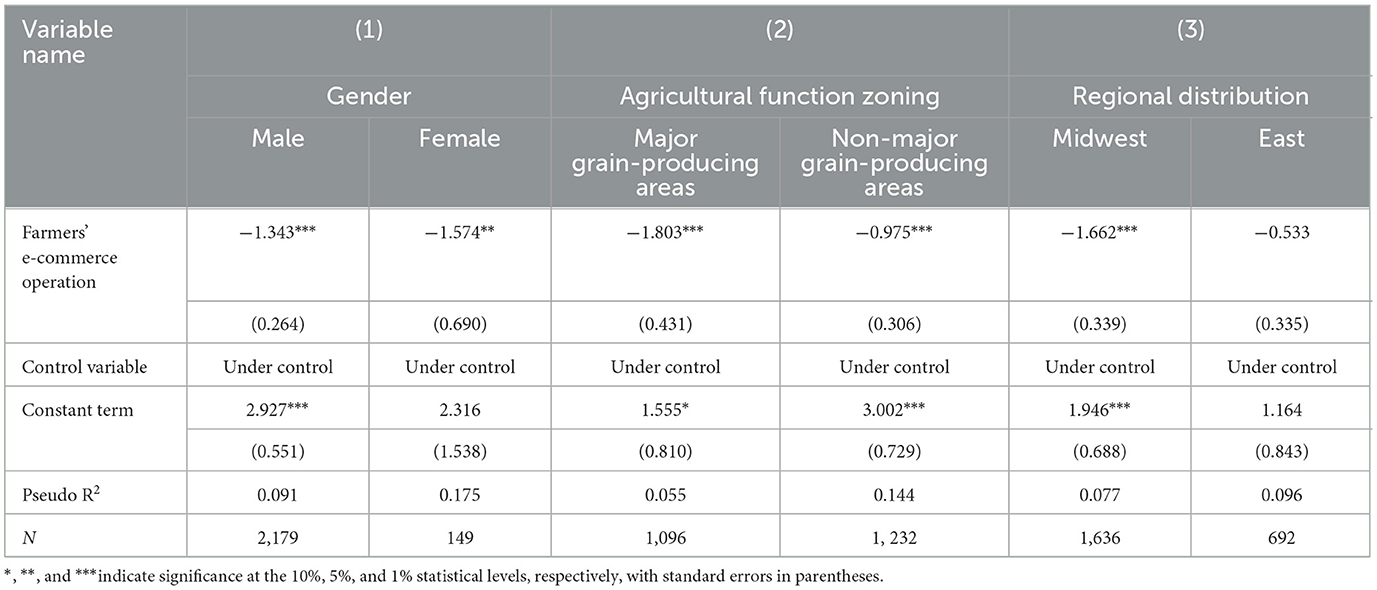
Table 9. Heterogeneity test results of e-commerce operation on farmers' chemical fertilizer application behavior.
Agricultural function zoning heterogeneity
Referring to the study of Zhang et al. (2021), this paper divides the agricultural function of different provinces according to whether they are major grain-producing areas and explores the heterogeneity of the impact of EO on FFA in agricultural function zoning, as shown in Column (2) of Table 9. compared with non-major grain-producing areas, EO has a more significant impact on the FFA in major grain-producing regions and had a more noticeable effect on the fertilizer reduction in major grain-producing areas.
Regional distribution heterogeneity
Considering the differences in economic development level and industrial structure in different regions, this paper further explores the regional heterogeneity of the impact of EO on FFA, and the results are shown in column (3) of Table 9. The results show that compared with the eastern region, e-commerce businesses can encourage farmers in the central and western areas to reduce fertilizer application, which is attributed to the widespread water shortage in the Midwest. Excessive water use increases fertilizer leaching, and reasonable control of fertilizer application can reduce crop water demand and improve water resource utilization, which is also necessary for fertilizer reduction in the central and western regions (Ali and Talukder, 2008). In addition, farmers in the west and central areas have gradually formed a more economical and environmentally friendly production concept in the long-term agricultural production, and the acceptance of fertilizer reduction is more significant. In conclusion, hypothesis 3 was verified.
Further discussion
The previous discussion presented the fertilizer reduction effect of e-commerce business, but the difference in the impact of different e-commerce business scales and these modes on FFA is not apparent. To this end, this paper further compares the effect differences of varying e-commerce business scales and e-commerce business models, aiming to answer which e-commerce business scale can better promote the reduction of FFA.
Differences in the fertilizer reduction of different e-commerce business scales
Taking the mean value of e-commerce sales as the cut-off point, this paper divides EO into scale e-commerce and non-scale e-commerce and investigates the influence of different scales of e-commerce operations on FFA. As shown in Table 10, compared with non-scale e-commerce, the regression coefficient of scale e-commerce on FFA is significantly negative at the statistical level of 1%, indicating that scale e-commerce can effectively encourage farmers to reduce fertilizer application amount. The potential reason is that farmers with large-scale operations have more funds and can choose higher-priced organic fertilizers to replace fertilizers. In contrast, farmers with large-scale operations pay more attention to product reputation and are more willing to adopt green production technology and reduce fertilizer application to obtain long-term benefits.
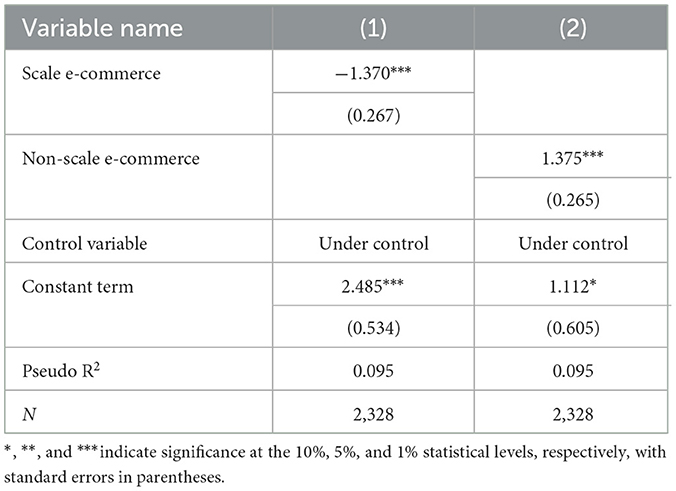
Table 10. Differences in the influence of different e-commerce operation scales on farmers' chemical fertilizer application behavior.
Differences in the fertilizer reduction of different e-commerce business models
Currently, two main sales models for agricultural products exist in rural areas. First, farmers open online stores to sell agricultural products on Jingdong, Taobao, Pinduoduo, and other e-commerce platforms. The second is the social e-commerce model, in which farmers sell agricultural products through social tools such as WeChat, Xiaohongshu, and Douyin (Liu et al., 2021). This paper investigated the effects of different e-commerce business models and traditional sales models on FFA, and the regression results are shown in Table 11. The regression coefficient of the conventional marketing model on FFA is significantly positive at the statistical level of 1% on the premise that other conditions remained unchanged. Due to factors such as concealment, asymmetry, and unidirectional fluidity of product information, the traditional marketing model would aggravate the excessive application of fertilizer. Although the platform e-commerce model has no significant effect on FFA, from the perspective of coefficient, farmers are allowed to reduce the amount of fertilizer applied in the production process. The impact of the social e-commerce model on FFA is significantly negative at the statistical level of 1%, indicating that the social e-commerce model can effectively encourage farmers to reduce fertilizer application.
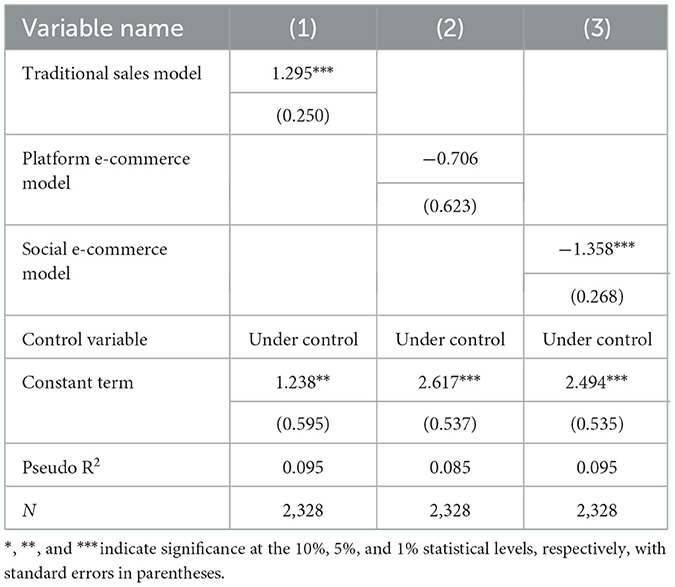
Table 11. Differences in the influence of different e-commerce business models on farmers' chemical fertilizer application behavior.
This result once again confirms the role of EO in promoting the reduction of fertilizers in farmers and indicates that the social e-commerce model has strong social characteristics, low cost, and light assets. Sellers can interact with consumers through social media, establish a close relationship, and reduce the transaction cost of technology adoption. This personalized interactive way can not only better meet the individual needs of consumers and improve consumer stickiness but also regulate the production behavior of producers, encourage farmers to green production, and reduce the amount of fertilizer application.
Conclusions and policy implications
Conclusion
Using the survey data of China's Rural Revitalization from August to September in 2020, the OLS Model, and the mediating effect model, this paper empirically tested the influence and mechanism of e-commerce operation on farmers' fertilizer application behavior. On this basis, the heterogeneous impact of e-commerce operations on farmers' fertilizer application behavior was investigated. Furthermore, the differentiated effects of different e-commerce operation scales and operation modes on farmers' fertilizer application behavior were further discussed. The conclusions were as follows:
First, e-commerce can significantly improve the FFA and reduce the amount of fertilizer applied. EO enhances market transparency, improves the price expectations of green products, and increases sales revenue so that farmers have more funds for green production investment, replace chemical fertilizers with organic fertilizers and formula fertilizers, and information disclosure and feedback mechanism of e-commerce will encourage farmers to pursue positive social evaluation, forcing farmers to transform into green farmers and reduce the amount of fertilizer application.
Second, agricultural machinery services positively mediate the influence of e-commerce operations on farmers' fertilizer application behavior. The development of e-commerce can optimize local infrastructure, improve local mechanization, and support the introduction of agricultural machinery services. The use of machinery by farmers in the process of fertilization can effectively improve the efficiency and accuracy of fertilization, control the amount of fertilizer applied, reduce unnecessary fertilizer loss and application, and gradually move toward a virtuous cycle of fertilizer reduction.
Third, the impact of e-commerce on FFA is heterogeneous in terms of gender, agricultural function zoning, and regional distribution. Specifically, women, farmers in major grain-producing regions, and farmers in the Midwest were more likely to reduce fertilizer use after operating e-commerce, which shows that the effect of CF reduction in e-commerce operations is affected by individual and regional endowments, and it is necessary to provide targeted assistance to agricultural producers and regions.
Fourth, the fertilizer reduction effect of large-scale e-commerce and social e-commerce is more apparent, indicating that while encouraging farmers to expand the scale of EO, we should strengthen support for new e-commerce models, provide personalized e-commerce services, strengthen the social connection between farmers and consumers, and exert the restraint effect of implicit “reputation capital” on fertilizer application behavior.
Policy implications
This paper draws the following policy implications. Firstly, The support for rural e-commerce can be made to strengthen the construction of rural infrastructure such as networks, transportation, and logistics, optimize the business environment, and enhance farmers' awareness of e-commerce participation.
Secondly, the subsidy level for green agricultural machinery can be increased to encourage more farmers to adopt agricultural machinery services, continue to promote land transfer and integration, and guide regional planting to develop toward scale and specialization, creating conditions for fully realizing the potential of fertilizer reduction in agricultural mechanization.
Thirdly, the group and regional characteristics of agricultural production can be considered to increase support for fertilizer reduction for agricultural production entities and regions, and promote the green transformation and ecological sustainable development of agricultural production comprehensively.
Fourthly, the diversified development and scale transformation of e-commerce are encouraged to strengthen support for new e-commerce models such as social e-commerce, and enable more farmers to share the benefits of e-commerce while reducing fertilizer usage, gradually forming a “point to surface” green production pattern.
Research limitations
This study is based on the 2020 China Rural Revitalization Survey data. Although it does not cover the rapid development of new rural e-commerce business forms in recent years, 2020 was the initial stage when China's “Digital Village” policy was fully rolled out and rural e-commerce began to penetrate agricultural production. The data can effectively capture the baseline characteristics of farmers' behavioral changes and the early policy effects. At the same time, the core policy goals of agricultural green transformation and fertilizer reduction have not fundamentally changed in recent years. The causal mechanism by which e-commerce influences farmers' decisions through information empowerment and market incentives still has theoretical stability. The research conclusions can provide references for policy optimization. In the future, we still need to verify the long-term robustness of the conclusions through tracking data.
Data availability statement
The original contributions presented in the study are included in the article/supplementary material, further inquiries can be directed to the corresponding authors.
Ethics statement
Ethical review and approval was not required for the study on human participants in accordance with the local legislation and institutional requirements. Written informed consent from the [patients/ participants OR patients/participants legal guardian/next of kin] was not required to participate in this study in accordance with the national legislation and the institutional requirements.
Author contributions
HQ: Project administration, Conceptualization, Data curation, Methodology, Writing – original draft, Writing – review & editing. YH: Formal analysis, Methodology, Writing – original draft. WZ: Formal analysis, Software, Supervision, Writing – review & editing. BH: Resources, Visualization, Writing – review & editing. RY: Investigation, Software, Writing – original draft. ZW: Investigation, Software, Writing – review & editing.
Funding
The author(s) declare that financial support was received for the research and/or publication of this article. The paper was supported by the National Social Science Foundation of China (No. 22CGL027).
Conflict of interest
The authors declare that the research was conducted in the absence of any commercial or financial relationships that could be construed as a potential conflict of interest.
Generative AI statement
The author(s) declare that no Gen AI was used in the creation of this manuscript.
Publisher's note
All claims expressed in this article are solely those of the authors and do not necessarily represent those of their affiliated organizations, or those of the publisher, the editors and the reviewers. Any product that may be evaluated in this article, or claim that may be made by its manufacturer, is not guaranteed or endorsed by the publisher.
References
Aker, J. C., and Ksoll, C. (2016).Can mobile phones improve agricultural outcomes? Evidence from a randomized experiment in Niger. Food policy. 60:44–51. doi: 10.1016/j.foodpol.2015.03.006
Ali, M. H., and Talukder, M. S. U. (2008). Increasing water productivity in crop production—A synthesis. Agr. Water Manage. 95, 1201–1213. doi: 10.1016/j.agwat.2008.06.008
Baron, R. M., and Kenny, D. A. (1986). The moderator–mediator variable distinction in social psychological research: conceptual, strategic, and statistical considerations. J. Pers. Soc. Psychol. 51:1173. doi: 10.1037/0022-3514.51.6.1173
Caliendo, M., and Kopeinig, S. (2008). Some practical guidance for the implementation of propensity score matching. J. Econ. Surv. 22, 31–72. doi: 10.1111/j.1467-6419.2007.00527.x
Cao, F., Ge, Y., and Wang, J. F. (2013). Optimal discretization for geographical detectors-based risk assessment. J. GISci. Remote Sens. 50, 78–92. doi: 10.1080/15481603.2013.778562
Chen, X., and Liu, T. (2023). Can agricultural socialized services promote the reduction in chemical fertilizer? Analysis based on the moderating effect of farm size. Int. J. Env. Res. Pub. He. 20:2323. doi: 10.3390/ijerph20032323
Cheng, K., Pan, G., Smith, P., Luo, T., Li, T., Zheng, J., et al. (2011). Carbon footprint of China's crop production—An estimation using agro-statistics data over 1993–2007. Agr. Ecosyst. Environ. 142, 231–237. doi: 10.1016/j.agee.2011.05.012
Couture, V., Faber, B., Gu, Y., and Liu, L. (2021). Connecting the countryside via e-commerce: evidence from China. Am. Econ. Rev. 3, 35–50. doi: 10.1257/aeri.20190382
Fang, H. (2023). Empowering women in rural china: redefining roles and reducing gender divides through online selling in family farming. Commun. Humanit. Res. 11, 150–158. doi: 10.54254/2753-7064/11/20231406
Fang, P., Abler, D., Lin, G., Sher, A., and Quan, Q. (2021). Substituting organic fertilizer for chemical fertilizer: evidence from apple growers in China. Land 10:858. doi: 10.3390/land10080858
Goetzke, B., Nitzko, S., and Spiller, A. (2014). Consumption of organic and functional food. A matter of well-being and health? Appetite 77, 96–105. doi: 10.1016/j.appet.2014.02.012
Guo, J., Jin, S., Zhao, J., Wang, H., and Zhao, F. (2022).Has COVID-19 accelerated the E-commerce of agricultural products? Evidence from sales data of E-stores in China. Food Policy 112, 102377. doi: 10.1016/j.foodpol.2022.102377
Guo, L., Li, H., Cao, X., Cao, A., and Huang, M. (2021). Effect of agricultural subsidies on the use of chemical fertilizer. J. Environ. Manage. 299:113621. doi: 10.1016/j.jenvman.2021.113621
He, Q., Sun, Y., Yi, M., and Hunag, H. (2023). How to promote agricultural enterprises to reduce the use of pesticides and fertilizers? An evolutionary game approach. Front. Sustain. Food Syst. 7:1238683. doi: 10.3389/fsufs.2023.1238683
Herzfeld, T., and Jongeneel, R. (2012). Why do farmers behave as they do? Understanding compliance with rural, agricultural, and food attribute standards. Land Use Policy 29, 250–260. doi: 10.1016/j.landusepol.2011.06.014
Hu, L. X., Zhang, X. H., and Zhou, Y. H. (2019). Farm size and fertilizer sustainable use: an empirical study in Jiangsu, China. J. Integr. Agr. 18, 2898–2909. doi: 10.1016/S2095-3119(19)62732-2
Huan, M., Li, Y., Chi, L., and Zhan, X. (2022).The effects of agricultural socialized services on sustainable agricultural practice adoption among smallholder farmers in China. Agronomy. 12:2198. doi: 10.3390/agronomy12092198
Huang, J., Huang, Z., Jia, X., Hu, R., and Xiang, C. (2015).Long-term reduction of nitrogen fertilizer use through knowledge training in rice production in China. Agr. Syst. 135, 105–111. doi: 10.1016/j.agsy.2015.01.004
Huang, J., and Rozelle, S. (1996). Technological change:rediscovering the engine of productivity growth in China's agricultural economy. J. Dev. Econ. 49, 337–369 doi: 10.1016/0304-3878(95)00065-8
Ji, X., Xu, J., and Zhang, H. (2023).Environmental effects of rural e-commerce: a case study of chemical fertilizer reduction in China. J. Environ. Manage. 326:116713. doi: 10.1016/j.jenvman.2022.116713
Ju, X. T., Xing, G. X., Chen, X. P., Zhang, S. L., Zhang, L. J., Liu, X. J., et al. (2009). Reducing environmental risk by improving N management in intensive Chinese agricultural systems. P. Natl. A. Sci. 106, 3041–3046. doi: 10.1073/pnas.0813417106
Kaspar, H. (2005). I am the Household Head Now! Gender Aspects of Out-Migration for Labour in Nepal. Kathmandu: NIDS, 149.
Kolotylo-Kulkarni, M., Xia, W., and Dhillon, G. (2021). Information disclosure in e-commerce: A systematic review and agenda for future research. J. Bus. Res.126, 221–238. doi: 10.1016/j.jbusres.2020.12.006
Leong, C., Pan, S. L., Newell, S., and Cui, L. (2016). The emergence of self-organizing E-commerce ecosystems in remote villages of China. Mis. Quart. 40,475–484. doi: 10.25300/MISQ/2016/40.2.11
Li, A. H. (2017). E-commerce and taobao villages: a promise for China's rural development?. China Perspect. 3, 57–62. doi: 10.4000/chinaperspectives.7423
Li, B., Xu, C., Zhu, Z., and Kong, F. (2021).Does e-commerce drive rural households engaged in non-timber forest product operations to adopt green production behaviors?. J. Clean. Product. 320:128855. doi: 10.1016/j.jclepro.2021.128855
Li, S., Zhang, Y., Nadolnyak, D., Wesley, J. D., and Zhang, Y. (2014). Fertilizer industry subsidies in China: who are the beneficiaries?. China Agr. Econ. Rev. 6, 433–451. doi: 10.1108/CAER-12-2012-0134
Lin, G., Xie, X., and Lv, Z. (2016).Taobao practices, everyday life and emerging hybrid rurality in contemporary China. J. Rural Stud. 47, 514–523. doi: 10.1016/j.jrurstud.2016.05.012
Lin, Y., Hu, R., Zhang, C., and Chen, K. (2022). Effect of agricultural extension services in the post-reform era since the mid-2000s on pesticide use in China: evidence from rice production. Int. J. Agr. Sustain. 20, 955–966. doi: 10.1080/14735903.2022.2028399
Lin, Z., and Wang, Q. (2018). E-commerce product networks, word-of-mouth convergence, and product sales. J. Assoc. Inf. Syst. 19:2. doi: 10.17705/1jais.00481
Liu, J., and Diamond, J. (2005). China's environment in a globalizing world. Nature 435, 1179–1186. doi: 10.1038/4351179a
Liu, M., Min, S., Ma, W., and Liu, T. (2021).The adoption and impact of E-commerce in rural China: Application of an endogenous switching regression model. J. Rural Stud. 83, 106–116. doi: 10.1016/j.jrurstud.2021.02.021
Liu, T., Li, C., Tan, W., Wang, J., Feng, J., Hu, Q., et al. (2022). Rice-crayfish co-culture reduces ammonia volatilization and increases rice nitrogen uptake in central China. Agr. Ecosyst. Environ. 330:107869. doi: 10.1016/j.agee.2022.107869
Liu, Y., Pan, X., and Li, J. (2015). A 1961–2010 record of fertilizer use, pesticide application and cereal yields: a review. Agron. Sustain. Dev. 35, 83–93. doi: 10.1007/s13593-014-0259-9
Lv, N., Liu, F., Zhu, H., and Wang, G. (2023). Effect of government intervention and market incentives on farmer organic fertilizer application behavior and agricultural emission reduction. Nat. Hazards Rev. 24:04022035. doi: 10.1061/(ASCE)NH.1527-6996.0000595
Pourhosseini, S. H., Azizi, A., Seyedi, F. S., and Hadian, J. (2024). Bio-fertilizer as a pathway to minimize nitrate leaching from chemical fertilizer in high yield peppermint. J. Clean. Prod. 468:143100. doi: 10.1016/j.jclepro.2024.143100
Qiu, H., Zhang, X., Feng, M., Zhang, Z., Wang, J., and Wang, Z. (2024). Exploring the income-increasing benefits of rural e-commerce in China: implications for the sustainable development of farmers. Sustainability 16:7437. doi: 10.3390/su16177437
Ren, Z. (2023). Effects of risk perception and agricultural socialized services on farmers' organic fertilizer application behavior: evidence from Shandong Province, China. Front. Public Health. 11:1056678. doi: 10.3389/fpubh.2023.1056678
Shen, Z., Wang, S., Boussemart, J. P., and Hao, Y. (2022). Digital transition and green growth in Chinese agriculture. Technol. Forecast. Soc. 181:121742. doi: 10.1016/j.techfore.2022.121742
Stuart, D., Schewe, R. L., and McDermott, M. (2014). Reducing nitrogen fertilizer application as a climate change mitigation strategy: understanding farmer decision-making and potential barriers to change in the US. Land Use Policy. 36, 210–218. doi: 10.1016/j.landusepol.2013.08.011
Tian, M., Zheng, Y., Sun, X., and Zheng, S. (2022). A research on promoting chemical fertiliser reduction for sustainable agriculture purposes: evolutionary game analyses involving ‘government, farmers, and consumers'. Ecol. Indic.144:109433. doi: 10.1016/j.ecolind.2022.109433
Wang, H., Fang, L., Mao, H., and Chen, S. (2022).Can e-commerce alleviate agricultural non-point source pollution?—A quasi-natural experiment based on a China's E-Commerce Demonstration City. Sci. Total Environ. 846:157423. doi: 10.1016/j.scitotenv.2022.157423
Wang, Y., Zhu, Y., Zhang, S., and Wang, Y. (2018). What could promote farmers to replace chemical fertilizers with organic fertilizers? J. Clean. Prod.199, 882–890. doi: 10.1016/j.jclepro.2018.07.222
Wooldridge, J. M. (2015). Introductory Econometrics: A Modern Approach (Sixth Edition). Boston, MA: Cengage Learning.
Wu, Y., Xi, X., Tang, X., Luo, D., Gu, B., Lam, S. K., et al. (2018). Policy distortions, farm size, and the overuse of agricultural chemicals in China. P. Natl. A. Sci. 115, 7010–7015. doi: 10.1073/pnas.1806645115
Yan, B., and Liu, T. (2022). Can E-commerce adoption improve agricultural productivity? Evidence from apple growers in China. Sustainability 15:150. doi: 10.3390/su15010150
Yang, C., Ji, X., Cheng, C., Shiou, C., Obuobi, B., and Yifeng, Z. (2024). Digital economy empowers sustainable agriculture: Implications for farmers' adoption of ecological agricultural technologies. Ecol. Indic. 159:111723. doi: 10.1016/j.ecolind.2024.111723
Yang, S., and Li, W. (2022). The impact of socialized agricultural machinery services on land productivity: evidence from China. Agriculture 12:2072. doi: 10.3390/agriculture12122072
Yang, Y., Li, Z., and Jin, M. (2022). How do chemical fertilizer reduction policies work?—Empirical evidence from rural China. Front. Env. Sci. 10:955278. doi: 10.3389/fenvs.2022.955278
Yi, X., Zou, Q., Zhang, Z., and Chang, S. H. (2023). What motivates greenhouse vegetable farmers to adapt organic-substitute-chemical-fertilizer (oscf)? An empirical study from Shandong, China. Int. J. Env. Res. Pub. He. 20,1146. doi: 10.3390/ijerph20021146
Yin, Y., Zhang, Y., Li, F., Jiao, J., Lebailly, P., Zhang, Y., et al. (2022). Driving mechanism for farmers' participation in improving farmland ecosystem: evidence from China. J. Clean. Prod. 380:134895. doi: 10.1016/j.jclepro.2022.134895
Yuan, F., Tang, K., and Shi, Q. (2021). Does Internet use reduce chemical fertilizer use? Evidence from rural households in China. Environ. Sci. Pollut. R. 28, 6005–6017. doi: 10.1007/s11356-020-10944-4
Yuan, F., Tang, K., Shi, Q., Qiu, W., and Wang, M. (2022). Rural women and chemical fertiliser use in rural China. J. Clean. Prod. 344:130959. doi: 10.1016/j.jclepro.2022.130959
Zeng, Y. M., Zhang, J. B., and He, K. (2019). The influence of intergenerational transmission of farming practices on organic fertilizer utilization willingness of rice producers. Chin. J. Eco-Agr. 27, 644–653. doi: 10.13930/j.cnki.cjea.180723
Zhang, D., Wang, H., and Lou, S. (2021). Research on grain production efficiency in China's main grain-producing areas from the perspective of grain subsidy. Environ. Technol. Inno. 22:101530. doi: 10.1016/j.eti.2021.101530
Zhang, L., Meng, T., Zhang, Z., and Mu, Y. (2023). Effects of organic fertilizer substitution on the technical efficiency among farmers: evidence from bohai rim region in China. Agronomy 13:761. doi: 10.3390/agronomy13030761
Zhang, Q., Chu, Y., Xue, Y., Ying, H., Chen, X., Zhao, Y., et al. (2020). Outlook of China's agriculture transforming from smallholder operation to sustainable production. Glob. Food Secur. 26:100444. doi: 10.1016/j.gfs.2020.100444
Zhang, Y., Long, H., Ma, L., Tu, S., Li, Y., and Ge, D. (2022). Analysis of rural economic restructuring driven by e-commerce based on the space of flows: the case of Xiaying village in central China. J. Rural Stud. 93, 196–209. doi: 10.1016/j.jrurstud.2018.12.001
Zhao, Q., Pan, Y., and Xia, X. (2021). Internet can do help in the reduction of pesticide use by farmers: evidence from rural china. Environ. Sci. Pollut. Res. Int. 28, 2063–2073. doi: 10.1007/s11356-020-10576-8
Zhao, Q. Q., Pan, Y. H., and Xian, X. L. (2019). Internet can do help in the reduction of pesticide use by farmers: Evidence from rural China. Land Use Policy 88:104193.
Zheng, S., Yin, K., and Yu, L. (2022). Factors influencing the farmer's chemical fertilizer reduction behavior from the perspective of farmer differentiation. Heliyon 8:e11918. doi: 10.1016/j.heliyon.2022.e11918
Keywords: e-commerce operation, farmer household, fertilizer application, agricultural machinery service, sustainable development
Citation: Qiu H, Huang Y, Zhang W, He B, Yuan R and Wang Z (2025) E-commerce operation empowers green agriculture: implication for the reduction of farmers' fertilizer usage. Front. Sustain. Food Syst. 9:1557224. doi: 10.3389/fsufs.2025.1557224
Received: 03 February 2025; Accepted: 14 April 2025;
Published: 13 May 2025.
Edited by:
Anas Tallou, Institute of Agrifood Research and Technology (IRTA), SpainReviewed by:
Emiliana Silva, University of the Azores, PortugalXiaoxiao Li, Hebei University of Economics and Business, China
Copyright © 2025 Qiu, Huang, Zhang, He, Yuan and Wang. This is an open-access article distributed under the terms of the Creative Commons Attribution License (CC BY). The use, distribution or reproduction in other forums is permitted, provided the original author(s) and the copyright owner(s) are credited and that the original publication in this journal is cited, in accordance with accepted academic practice. No use, distribution or reproduction is permitted which does not comply with these terms.
*Correspondence: Bing He, YmluZ2hlQGhrdS5oaw==; Ruolan Yuan, MTM3MzI5MjQ2ODBAMTYzLmNvbQ==; Zhipeng Wang, d3poaXBlbmcxOTkxQDE2My5jb20=
 Hailan Qiu
Hailan Qiu Yi Huang
Yi Huang Weikun Zhang
Weikun Zhang Bing He
Bing He Ruolan Yuan
Ruolan Yuan Zhipeng Wang
Zhipeng Wang